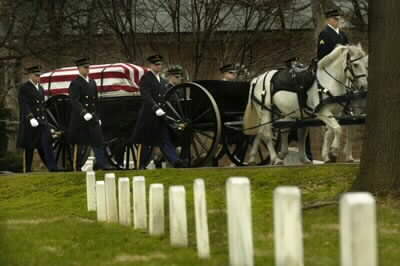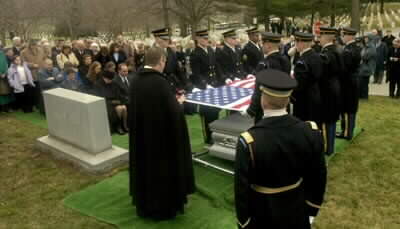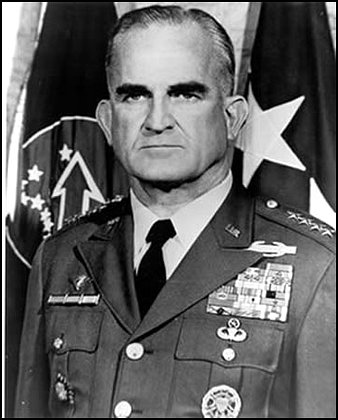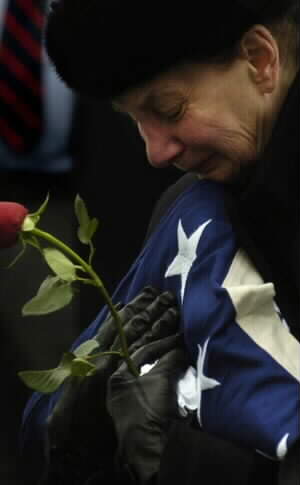From contemporary press reports
William B. Rosson, a retired four-star Army general and a former board member of the National D-Day Memorial Foundation, died of a heart attack December 12, 2004. He was 86.
General Rosson, whose military honors spanned World War II to the Vietnam War, suffered a heart attack at his home in Salem, Virginia, said his widow, Bertha Mitchell Rosson.
An Iowa native, General Rosson grew up in Oregon. He graduated from the University of Oregon in 1940 and later received a master’s degree in international relations from Oxford University.
He was commissioned a Second Lieutenant in the Army and fought in 10 campaigns in North Africa and Europe in World War II. He received the Distinguished Service Cross, the nation’s second-highest decoration for valor, and rose to Lieutenant Colonel by the war’s end.
He later served on the Army General Staff at the Pentagon, in Gen. Dwight D. Eisenhower’s NATO headquarters in Paris and on the staff of the chairman of the Joint Chiefs.
In the Vietnam War, General Rosson served a tour as General William Westmoreland’s chief of staff.
He retired in 1975 as commander in chief of the U.S. Southern Command in the Panama Canal Zone.
General Rosson’s many awards included the Bronze Star, the Legion of Merit, a Purple Heart and the Doughboy Award, the infantry’s highest award.
He retired to Florida, but later moved to Salem when he married Bertha Mitchell.
Mike Shelton, former mayor of Bedford, where the D-Day Memorial is located, credited General Rosson’s vision in helping to create the memorial.
“I think a lot of what you see in the memorial is a direct reflection of General Rosson,” he said. “He’s got a deep, deep imprint in that memorial.”
4-Star Army Gen. William Rosson, 86
By Patricia Sullivan
Courtesy of the Washington Post
Friday, December 17, 2004
William B. Rosson, 86, a retired four-star Army General who was a Battalion Commander at Anzio, Italy, in World War II and a senior commander in Vietnam and served on the board of the National D-Day Memorial Foundation, died Dec. 12 after a heart attack at his home in Salem, Virginia.
General Rosson, who entered the Army in 1940, immediately after graduating from the University of Oregon, served four tours of duty in Vietnam, longer than any other senior commander in that war. He retired in 1975 after two years as commander in chief of the Southern Command in the Panama Canal Zone.
At 25, he received the Distinguished Service Cross, the nation’s second-highest military honor, for his actions in the brutal campaign at Anzio. He participated in four amphibious assaults during World War II, helping plan the invasion of southern France and fighting with VI Corps all the way to Germany. He was a regimental commander early during the occupation of Germany.
Rosson, a great soldier at 25, also was an impressive staff officer at that age, said Gordon Rudd, a military historian who teaches at the Marine Corps Command and Staff College. “He was not a Westmoreland, he was not a MacArthur, he was not a high-profile guy. . . . He was more like Omar Bradley, who was a soldier’s soldier.”
In World War II, he fought in 10 campaigns with the 3rd Infantry, in such locales as North Africa and Germany.
He received many military awards and decorations, including the Legion of Merit, the Bronze Star, the Purple Heart and the Doughboy Award, the infantry’s highest award. Apparently, he did not take the awards too seriously.
After the war, while working in Europe under Bernard Montgomery, the British field marshal, Rosson noted that Montgomery was wearing all of his 38 ribbons. According to a story that made the rounds of NATO headquarters, Montgomery then asked each officer in the room, in turn, how many ribbons he had earned. Rosson, who had no idea how many awards he had, answered, “Thirty-nine.” Montgomery left the room in a huff, and the American’s popularity with British staff officers soared.
General Rosson also displayed physical courage in his career. In 1954, while assigned to a military advisory group in Indochina, he flew over the battle of Dien Bien Phu, the bloody altercation that ended French involvement in Vietnam. The first two Americans killed in Vietnam combat, both civilians, died in similar flyovers, downed by withering antiaircraft fire from Vietminh.
Gen. Rosson, who subsequently served in Germany and at the Pentagon, returned in 1965 to Vietnam, where he was chief of staff for Westmoreland. He took over I Corps for a Marine commander on leave, a rare case in which an Army officer was in command of a predominantly Marine formation. Gen. Rosson subsequently formed a division of separate units that became the Americal Division and later became deputy commander in Vietnam under Gen. William Abrams. From 1970 to the end of 1972, he was commander in chief of the Army in the Pacific before ending his military career in Panama.
After his retirement, Gen. Rosson received a master of letters degree in international relations from Oxford University.
He moved to Salem, near Roanoke, in 1984, after he married Bertha Mitchell Rosson, and became involved with the National D-Day Memorial efforts. His wife survives him.
“He was a great, strong supporter. He was a great man for detail,” said William Bagbey, the founding chairman of the foundation that built the memorial. “Of course, he was not one who pushed himself to the front, but he did, by his actions, get very much to the front.”
United States Army Biography:
General Rosson fought in ten campaigns with the 3rd Infantry Division in World War II in North Africa, Sicily, Italy, France, and Germany. Wounded in Sicily, he went on to win the nation’s second highest decoration for valor, The Distinguished Service Cross, on the “Anzio Beachhead in Italy.”
He later served on the Army General Staff in the Pentagon, in General Eisenhower’s NATO headquarters in Paris, France, and on the staff of the Chairman of the Joint Chiefs of Staff, again in the Pentagon. Troop duty Included command of two Infantry regiments in Germany, and command of the European Airborne Brigade, also in Germany.
General Rosson served four tours in Vietnam covering six years. His assignments included:
Commissioned 1940 as a Second Lieutenant of Infantry
Battalion Commander with the 3rd Infantry Division, 10 campaigns in Europe
Commander, 30th Infantry Regiment, Army of Occupation, Germany, 1945-1946
Instructor, Command and General Staff College, 1946-1949
Joint War Plans Branch, Army General Staff, Washington, D.C., 1949-1951
Plans, Policy and Operations Division, Supreme Headquarters Allied
Powers Europe, Paris, 1951-1953
Army War College, Carlisle Barracks, 1953
U.S. Military Advisory Group Indo-China, 1954
Commander, 39th Infantry Regiment, 9th Infantry Division, Germany, June 1955-June 1956
Army Member, Chairman’s Staff Group, Joint Chief of Staff, Washington, D.C., 1956-1959
National War College, 1960
Assistant Deputy Chief of Staff for Operations, USAREUR, Germany, 1960-1961
Assistant Division Commander and Airborne Brigade Commander, 8th Infantry Division, Germany, 1961-1962
Special Assistant to the Chief of Staff, U.S. Army, for special warfare, 1962-1963
Director, U.S. Strike Command Joint Test and Evaluation Tak Force, 1963-1965
Chief of Staff, United States Military Assistance Command, Vietnam (MACV), 25 June 1965-April 1967
Commanding General, Task Force Oregon (later the 23d Infantry (Americal) Division), April 1967-June 1967
Commanding General, IFFV 31 July 1967-1 March 1968
Deputy Commanding General, U.S. Military Assistance Command Forward, Vietnam (MACV), 1 March 1968-10 March 1968
Commanding General, Provisional Corps (later XXIV Corps), Vietnam, 10 March 1968-31 July 1968.
Director, Policy and Plans Directorate, Joint Chiefs of Staff, Washington, D.C., August 1969-April 1969
Special Assistant to COMUSMACV, U.S. Military Assistance Command, Vietnam, April 1969
Deputy Commander, U.S. Military Assistance Command, Vietnam (MACV), 1 May 1969-15 October 1970
Commander in Chief, U.S. Army Pacific (USARPAC), Hawaii, 16 October 1970-January 1973
Commander in Chief, United States Southern Command, Canal Zone, January 1973 to July 1975
After serving as Commander in Chief of United States Army Forces in the Pacific from 1970 to 1973, General Rosson completed his career in Latin America by serving as Commander in Chief, United States Southern Command from January 1973 to July 1975, with headquarters in the Canal Zone.
General Rosson is a graduate of the Army Command and General Staff College, The Army War College, and the National War College.
LTG Rosson, CG, IFFV, in 192d AHC C&C
Chopper over Binh Thuan Province, 1968.
Photo by Jerry Berry, 3/506/101
Civilian Career/Achievements:
Following retirement in 1975, General Rosson obtained a Master of Letters degree in international relations from Oxford University in England. In 1984, the General moved from Florida to Roanoke, Virginia. Among his present pursuits are lecturing on national security and international relations, serving as a panelist, conducting professional research and writing for military agencies and journals.
ROSSON, WILLIAM BRADFORD
General, US Army (Ret.), 86
On December 12, 2004. Beloved husband of Bertha R. Rosson; step father of two, grandfather of seven. Services 10 a.m., Monday, December 20 at St. Paul’s Episcopal Church, Salem, Virginia. Interment Arlington National Cemetery, 11 a.m., Tuesday, January 11, 2005 with Full Military Honors.
Tuesday, January 11, 2005
Rosson buried at Arlington National Cemetery
ARLINGTON, VIRGINIA — The black horse came last — tall and graceful, four stars shining on its empty saddle, a pair of empty boots turned backward in the stirrups — heralding the death of another old soldier.
William B. Rosson, a retired four-star Army General and a former board member of the National D-Day Memorial Foundation, was buried today in an emotional ceremony attended by about 150 family, friends and military officials. Many took a 5 a.m. bus ride from the Roanoke Valley to attend the burial.
Rosson, a Salem resident, was eulogized as an American hero, a gentleman and a man of courage.
“He was gracious until the day he died,” said Lorraine Simms, a Salem neighbor.
Rosson, 86, died December 12, 2004, of a heart attack at home.
On a mild winter day under leaden skies, he was buried at Arlington National Cemetery with full military honors, including a 17-cannon shot salute, a caisson pulled by six horses, an honor guard, a 45-piece band and a full infantry platoon.


ROSSON, WILLIAM B
- GEN US ARMY
- VETERAN SERVICE DATES: 08/25/1938 – 08/01/1975
- DATE OF BIRTH: 08/25/1918
- DATE OF DEATH: 12/12/2004
- DATE OF INTERMENT: 01/11/2005
- BURIED AT: SECTION 30 SITE 877
ARLINGTON NATIONAL CEMETERY
Michael Robert Patterson was born in Arlington and is the son of a former officer of the US Army. So it was no wonder that sooner or later his interests drew him to American history and especially to American military history. Many of his articles can be found on renowned portals like the New York Times, Washingtonpost or Wikipedia.
Reviewed by: Michael Howard


